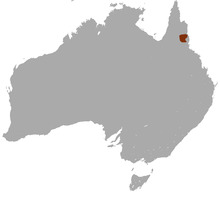| Mareeba rock-wallaby[1] | |
|---|---|
 | |
| Mareeba rock-wallaby with joey | |
| Scientific classification | |
| Kingdom: | Animalia |
| Phylum: | Chordata |
| Class: | Mammalia |
| Infraclass: | Marsupialia |
| Order: | Diprotodontia |
| Family: | Macropodidae |
| Genus: | Petrogale |
| Species: | P. mareeba |
| Binomial name | |
| Petrogale mareeba Eldridge & Close, 1992 | |
 | |
| Mareeba rock-wallaby range (brown), within Australia | |
The Mareeba rock-wallaby (Petrogale mareeba) is a rare species of rock-wallaby found around Mareeba in northeastern Queensland, Australia.
Taxonomy
The Mareeba rock-wallaby is a member of a group of seven very closely related species within the genus Petrogale, which also includes the Cape York rock-wallaby (P. coenensis), the unadorned rock-wallaby (P. inornata) and the allied rock-wallaby (P. assimilis). It was only identified as a separate species in 1992.[3] Both the common name and the Latin specific epithet reflect the distribution of this species around the settlement of Mareeba.
Distribution and habitat
The Mareeba rock-wallaby is a rare species, found in the highlands west of Cairns from around Mount Garnet to the Mitchell River and Mount Carbine, and inland to Mungana,[4] but only on the tops of a couple of mountain ranges.[3] The animals can be seen in their natural habitat in the Granite Gorge Nature Park, about 60 kilometres (37 mi) inland from Cairns.[3]
Conservation
Classification
Although rare, and a near-threatened species under IUCN classification,[2] the animal is classed as one of "Least concern" under Queenland's Nature Conservation Act 1992.[5]
Survival after bushfires
After a huge fire raged through the Yourka Reserve near Einasleigh, run by Bush Heritage Australia in December 2019, part of the 2019–2020 bushfires in Australia, it was feared that the rock-wallaby population might not survive. However, it was found that the population was thriving, with several new joeys spotted in their mothers' pouches, using motion-sensing cameras. Reserve manager Paul Hales said that they had been conducting cool burns for years, in order to reduce dense tree foliage which had prevented the growth of native grasses such as cockatoo grass and kangaroo grass, but the December fire had helped to thin out the trees even more, "with daylight reaching the ground for the first time in 25 years". The renewed growth would help to support the survival of the ground-dwelling native animals.[6]
References
- ^ Groves, C. P. (2005). Wilson, D. E.; Reeder, D. M. (eds.). Mammal Species of the World: A Taxonomic and Geographic Reference (3rd ed.). Baltimore: Johns Hopkins University Press. p. 68. ISBN 0-801-88221-4. OCLC 62265494.
- ^ a b Winter, J.; Burnett, S. & Martin, R. (2008). "Petrogale mareeba". IUCN Red List of Threatened Species. 2008. Retrieved 29 December 2008.
- ^ a b c "Mareeba Rock Wallaby Australia". Thala Beach Nature Reserve Resort, Port Douglas Australia. 27 August 2012. Retrieved 26 June 2020.
- ^ Menkhorst, Peter (2001). A Field Guide to the Mammals of Australia. Oxford University Press. p. 130.
- ^ "Species profile -Petrogale mareeba (Mareeba rock-wallaby)". Queensland Government. 20 October 2014. Retrieved 26 June 2020.
- ^ Sexton-McGrath, Kristy (24 June 2020). "Mareeba rock-wallabies bounce back after bushfire - and now there's been a baby boom". ABC News. Australian Broadcasting Corporation. Retrieved 26 June 2020.
Further reading
- "Fact Sheet - Mareeba Rock-wallaby". Home of Rootourism and the Kangaroo Trail.
- "Petrogale mareeba(Mareeba Rock Wallaby)". Zipcode Zoo. Archived from the original on 30 September 2007.
